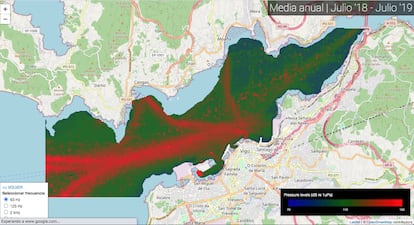Fishing for noise pollution under the seas
Spanish scientist Soledad Torres-Guijarro says two-thirds of marine animals are negatively affected by all the artificial sound in the oceans
The Silent World was the title of explorer and marine biologist Jacques Cousteau’s 1995 documentary about the world’s oceans. The film he made with French director Louis Malle won the Palme d’Or at the 1956 Cannes Film Festival and was hugely successful. It was also the title of Cousteau’s first book. But the notion that the underwater world is a tranquil place is a myth – it’s noisy down there. There has always been noise, and there is more and more of it every day. And that’s not good.
“There is noise down there, a lot of it,” said Soledad Torres-Guijarro, a professor at the University of Vigo (Galicia, Spain). She knows because her research focuses on collecting (she calls it “fishing”) marine noises of anthropocentric origin. In other words, the noise produced by human activity. Torres-Guijarro, a telecommunications engineer by training, created a database of underwater noise in 2016. “When we first began working on underwater acoustics we discovered that there were no public databases of noise caused by maritime traffic. We live in Vigo, which has an estuary heavily trafficked by ships. So we created a database of recordings that we shared with more than 300 research groups worldwide. We also developed an application to visualize the noise in the estuary on a map.”
These anthropocentric noises in the sea have become a severe global problem because they affect the physiology and behavior of marine life. International organizations recognize anthropocentric marine noise as a significant environmental stressor that can have disastrous consequences for the survival of populations and even entire species. “The focus was on cetaceans [dolphins, porpoises and whales] for a long time. But for the last decade, research has also focused on how underwater noise affects the rest of the creatures that live there. Around two-thirds of marine life suffer the impacts of noise pollution,” said Torres-Guijarro.
Marine animals make noise, just like land animals. Ocean mammals have evolved to use sound as a source of information. “We are recording dolphin whistles in Cortegada, one of the islands off the coast of Galicia. We placed a permanent hydrophone that can detect these whistles,” said Torres-Guijardo. “Dolphin communication is incredible. Recent research has discovered that each individual has a specific identifying whistle – like a name. Their communication even has a grammar, which means it’s a language.”
Marine mammals and seabirds perceive noise through changes in pressure, like people. That does not happen to most fish and aquatic invertebrates with no hearing ability. But this doesn’t mean they cannot feel the noise impacts. Instead, they perceive the movement of particles displaced by underwater sound. This particle movement can cause the same damage that sound produces in mammals and birds.
Various activities cause all these noises. “Most noise pollution is caused by the almost continuous maritime traffic in practically every ocean,” said Torres-Guijarro. “Other high-energy activities produce very harmful noise but are much shorter events occurring in specific areas. An example is the seismic exploration of ocean floors for oil and gas deposits. Compressed air guns launch high-energy sound pulses, which are analyzed for echoes that provide information about the subsoil.” She said that other major noise producers are coastal construction projects and powerful ship sonar equipment that can be very harmful, especially the type used on military vessels.
The problem with underwater noise is not the amount; it’s that sound propagates particularly well in water. “The difference between the propagation of sound in air versus water is that it propagates up to four times faster in water. And it also goes farther, sometimes hundreds of miles,” said Torres-Guijarro.

Many marine animals have exploited the sound-propagation capacity of water to develop capabilities such as moving, communicating or locating food, which depend on the capture or emission of sounds. The pervasiveness of artificial underwater sound interferes with the sounds produced by animals, which hinders their lives.
“We are conducting experiments on how noise affects two species of bivalves: clams and mussels,” said Torres-Guijarro. “In our laboratory, we subject mussels and clams to excitation using loudspeakers that reproduce underwater noise conditions. We conducted the experiment on mussels with José Gabarro, a biologist with the Spanish National Research Council’s [CSIC] Marine Research Institute, and the results are quite conclusive. When a mussel is subjected to a certain noise level, it closes up. A bivalve that closes cannot feed, damaging its health and growth over time. We are conducting the experiment on clams with biologist Elsa Vázquez of the University of Vigo. We have not finished the experiment, but we are beginning to see that they bury themselves when subjected to noise. Like mussels, they feel threatened by the noise and suffer the same consequences. When clams are buried, they cannot feed; if they don’t feed, they don’t grow.”
Not only does underwater noise cause stress to the species that inhabit the oceans, says Torres-Guijarro, but “in many places, what it produces is an incompatibility with marine life.”
Sign up for our weekly newsletter to get more English-language news coverage from EL PAÍS USA Edition
Tu suscripción se está usando en otro dispositivo
¿Quieres añadir otro usuario a tu suscripción?
Si continúas leyendo en este dispositivo, no se podrá leer en el otro.
FlechaTu suscripción se está usando en otro dispositivo y solo puedes acceder a EL PAÍS desde un dispositivo a la vez.
Si quieres compartir tu cuenta, cambia tu suscripción a la modalidad Premium, así podrás añadir otro usuario. Cada uno accederá con su propia cuenta de email, lo que os permitirá personalizar vuestra experiencia en EL PAÍS.
¿Tienes una suscripción de empresa? Accede aquí para contratar más cuentas.
En el caso de no saber quién está usando tu cuenta, te recomendamos cambiar tu contraseña aquí.
Si decides continuar compartiendo tu cuenta, este mensaje se mostrará en tu dispositivo y en el de la otra persona que está usando tu cuenta de forma indefinida, afectando a tu experiencia de lectura. Puedes consultar aquí los términos y condiciones de la suscripción digital.











































